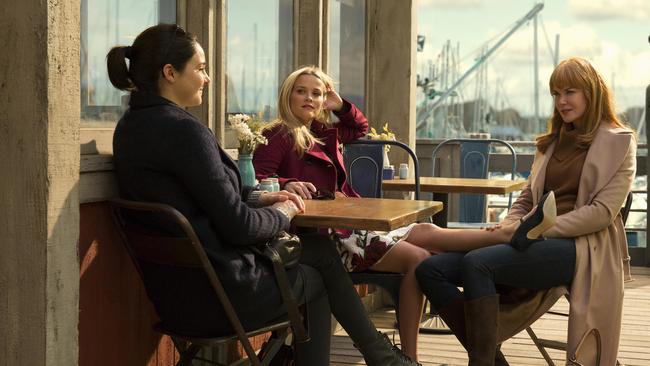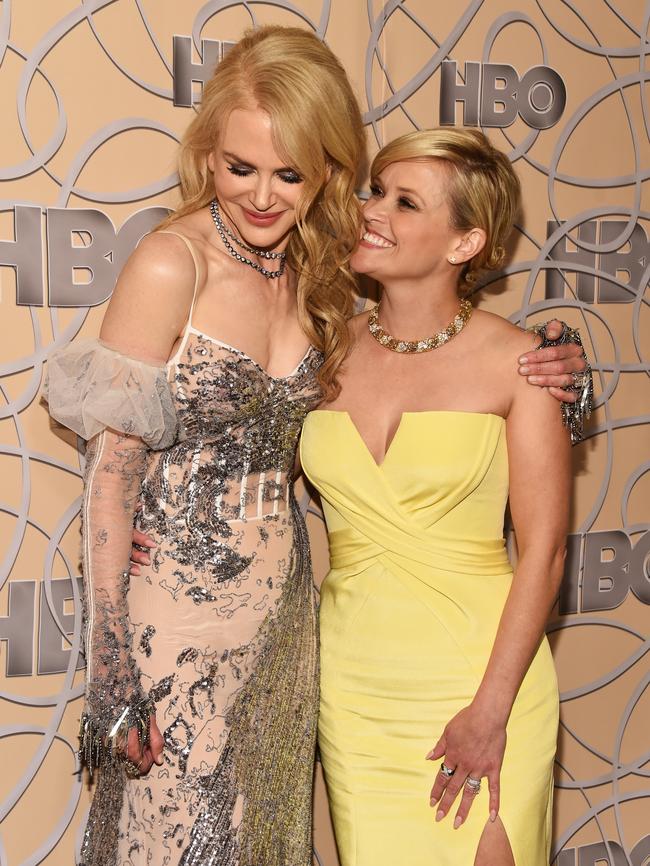Big Little Lies get underway with Reese Witherspoon and Nicole Kidman
The adaptation of Big Little Lies transports its malevolence and mystery from Sydney to California.

Much anticipated, and in no way disappointing, HBO’s Big Little Lies is the new “limited” seven-part series about secrets, deceit and emotional dishonesty, the moral dilemmas they generate, and their heartbreaking consequences. It is limited in the sense it has been created in a way that a second act is inconceivable, something so welcome in this era of epic, often enervating TV storytelling when some shows seem to never want to end.
Conceived as a seven-hour film rather than a TV miniseries, it was shot like one by Canadian director Jean-Marc Vallee (Dallas Buyer’s Club, Wild) across 88 days and nights, affording the production time to develop characters and explore its interconnecting stories in a way a conventional 120-minute movie is often unable to do. And it’s that detail that engrosses in this stunning display of human folly and cruelty.
Based on the sixth bestseller by Australian writer Liane Moriarty, who has sold more than six million novels, and is often referred to as the most successful writer you’ve never heard of — though that status will now change rapidly — it is executive produced by its stars Reese Witherspoon and Nicole Kidman, who picked up the rights in 2014. (The project was dubbed the female True Detective in pre-production, given the stellar talent involved.)

Originally set among a group of women with kindergarten-age kids in suburban Sydney, it has been transposed to glamorous coastal Monterey in California, a locale made famous by John Steinbeck. It has come a long way from the fish-packing plants, bordellos and flophouses he described in Cannery Row; it’s now a place divided by wealth, domestic mysteries and public rivalries. It is somewhere where everyone knows each other’s business, in voyeuristic detail.
The series also features Shailene Woodley (Divergent, The Fault in Our Stars) and Alexander Skarsgard (True Blood, The Legend of Tarzan), and the drama is created and written by David E. Kelley (Ally McBeal, Boston Legal).
Kelley, until now a victim of the cable-led revolution — his talk-driven scripting seemingly a tad old-fashioned — gives us a scintillating drama lit with dashes of his quirky, absurdist, often screwball humour.
He explores the unlovely places of blended families, infidelity, the repercussions of divorce, domestic violence, the maliciousness of gossip and competitiveness among women, and bullying — not only in the context of school but the way friends can lethally turn on each other. And it is brilliantly contained within the context of three mothers of children all starting at the same school on the same day becoming embroiled in a homicide investigation.
At the end of the first episode we have no idea who has died at the school’s annual fundraiser or how it happened, even as a gallery of the town’s characters work their hardest to enlighten us. Their extreme close-ups intrude abruptly, locking us into the gears of the plot and heightening the tension. It is an unusual and clever device.
The town’s chief suspect, though not necessarily that of the police at this point, is Witherspoon’s stay-at-home mum Madeline Mackenzie, a garrulous bombshell of a woman drawn, according to her husband, to damaged people, and who finds time to work in community theatre. “She grew up wanting to be Betty Grable,” says one of the chorus, disparagingly.
It is quickly clear she loathes her ex’s new, younger wife Bonnie (Zoe Kravitz), a yoga instructor with an annoying sense of equanimity, who, says Madeline, “probably gives him mint-flavoured blow jobs”. Madeline has the gift of the gab, “an active talker” according to her somewhat estranged older daughter Abigail (Kathryn Newton), who admires Bonnie.
Then there’s Madeline’s best friend, the oh-so-beautiful Celeste Wright (Nicole Kidman), a former corporate lawyer in an apparently idyllic marriage with a younger man (Skarsgard). And new to the scene, nervy and vulnerable, is Jane Chapman (Woodley), a single mum with some kind of troubled past, whom Madeline and Celeste adopt when her son is accused of bullying another child during the school’s orientation day. Jane is someone who feels she is always on the outside looking in, sure that good times don’t belong to her.
Rounding out the possible suspects is the spiky Renata Klein (Laura Dern), a career woman, nemesis to Madeline and mother of the little girl who was bullied. “He picked the wrong little girl to strangle,” says a witness to the playground altercation that leads to the night of the murder. “The battlegrounds were drawn right there,” says another. “Things never blow over once Madeline gets involved; they blow up,” adds someone else.
“When we first started the project, there was a question mark in terms of the tone, because the book is at times silly and at times very, very ugly,” Kelley told Variety recently. “I think that we stay very true to the dramatic tentpoles of the piece, but allow ourselves to be funny where we can, because life often is. Even if you don’t feel like laughing, sometimes it laughs at you.”
Vallee is a master of narrative technique and is much in demand in Hollywood for his stripped-down approach. From the accounts of his mesmerised actors, he is determined to make the physically and emotional acting process as light and simple as possible. He’s also been described as “an actor whisperer”, demanding rigour and intensity from those who may be inclined to take it easy, letting their fame work for them.
His camera movements and placements are unobtrusive but highly imaginative, scooping drama out of every nook with a cool elegance. Vallee likes to shoot using a handheld camera, rather like Steven Soderbergh in his brilliant The Knick, and where possible uses available light. Entire scenes are presented with no close-ups, the framing oblique and the lighting dim, moody and gorgeous.
It is a kind of hall-of-mirrors storytelling style in which the evolving narrative is reflected in the filmmaking process. Scenes sometimes seem to overlap slightly, merging for moments, and bringing meaning from one to another. Others are poetically and briefly repeated. There are recurring images of footsteps in sand that seem to lead nowhere, the sudden intrusion of a man holding and loading a handgun in close-up, and the characters sometimes just gaze mysteriously out to sea.
The long end sequence is brilliant: intercut scenes of the central women quietly pensive in their homes, isolated, shocked, with a sense of subdued hopelessness overlaying everything. The progression of sombre images is linked by a piano track, played by Madeline, and then a shutter abruptly closes them out, taking us to the end titles.
It is easy to eulogise all the actors but Witherspoon, making her TV debut (other than a brief stint on Friends), is given the plummiest lead role. Spontaneity and that ephemeral smile, the way it expands into pleasure, immodesty, love and hope — Witherspoon steals every scene in which she appears. However, towards the end of the first episode her charming garrulousness is repressed and her increasing sense of isolation from her daughters is beautifully played, too. She really is some actress.
As is Kidman. I’ve said before, she rivets your attention like an old-time movie star, as if she can somehow wall herself off from the ravages of ordinary experience and time. It is the same here, though initially she does little but exude beauty, something much remarked on by the other women, not unkindly, but there’s also a kind of trembling vulnerability just below the surface. This is a series not to be missed.
Big Little Lies, Monday, 1pm, Showcase.




To join the conversation, please log in. Don't have an account? Register
Join the conversation, you are commenting as Logout